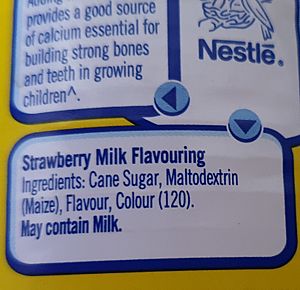Food additive facts for kids


A food additive is a substance that is added to certain foods to make them better in some ways. Some additives have been used for centuries, like salting fish or using vinegar to preserve vegetables (called pickling). Another use for additives is to use them for food coloring.
Food additives also include substances that may be introduced to food indirectly (called "indirect additives") in the manufacturing process, through packaging, or during storage or transport.
Contents
Numbering
To regulate these additives and inform consumers, each additive is assigned a unique number called an "E number", which is used in Europe for all approved additives.
E numbers are all prefixed by "E", but countries outside Europe use only the number, whether the additive is approved in Europe or not. For example, acetic acid is written as E260 on products sold in Europe, but is simply known as additive 260 in some countries. Additive 103, alkannin, is not approved for use in Europe so does not have an E number, although it is approved for use in Australia and New Zealand. Since 1987, Australia has had an approved system of labelling for additives in packaged foods. Each food additive has to be named or numbered. The numbers are the same as in Europe, but without the prefix "E".
The United States Food and Drug Administration (FDA) lists these items as "generally recognized as safe" (GRAS); they are listed under both their Chemical Abstracts Service number and FDA regulation under the United States Code of Federal Regulations.
Categories
Food additives can be divided into several groups, although there is some overlap because some additives exert more than one effect. For example, salt is both a preservative as well as a flavor.
- Acidulents
- Acidulants confer sour or acid taste. Common acidulents include vinegar, citric acid, tartaric acid, malic acid, fumaric acid, and lactic acid.
- Acidity regulators
- Acidity regulators are used for controlling the pH of foods for stability or to affect activity of enzymes.
- Anticaking agents
- Anticaking agents keep powders such as milk powder from caking or sticking.
- Antifoaming and foaming agents
- Antifoaming agents reduce or prevent foaming in foods. Foaming agents do the reverse.
- Antioxidants
- Antioxidants such as vitamin C are preservatives by inhibiting the degradation of food by oxygen.
- Bulking agents
- Bulking agents such as starch are additives that increase the bulk of a food without affecting its taste.
- Food coloring
- Colorings are added to food to replace colors lost during preparation or to make food look more attractive.
- Fortifying agents
- Vitamins, minerals, and dietary supplements to increase the nutritional value
- Color retention agents
- In contrast to colorings, color retention agents are used to preserve a food's existing color.
- Emulsifiers
- Emulsifiers allow water and oils to remain mixed together in an emulsion, as in mayonnaise, ice cream, and homogenized milk.
- Flavors
- Flavors are additives that give food a particular taste or smell, and may be derived from natural ingredients or created artificially.
- Flavor enhancers
- Flavor enhancers enhance a food's existing flavors. A popular example is monosodium glutamate. Some flavor enhancers have their own flavors that are independent of the food.
- Flour treatment agents
- Flour treatment agents are added to flour to improve its color or its use in baking.
- Glazing agents
- Glazing agents provide a shiny appearance or protective coating to foods.
- Humectants
- Humectants prevent foods from drying out.
- Tracer gas
- Tracer gas allow for package integrity testing to prevent foods from being exposed to atmosphere, thus guaranteeing shelf life.
- Preservatives
- Preservatives prevent or inhibit spoilage of food due to fungi, bacteria and other microorganisms.
- Stabilizers
- Stabilizers, thickeners and gelling agents, like agar or pectin (used in jam for example) give foods a firmer texture. While they are not true emulsifiers, they help to stabilize emulsions.
- Sweeteners
- Sweeteners are added to foods for flavoring. Sweeteners other than sugar are added to keep the food energy (calories) low, or because they have beneficial effects regarding diabetes mellitus, tooth decay, or diarrhea.
- Thickeners
- Thickening agents are substances which, when added to the mixture, increase its viscosity without substantially modifying its other properties.
- Packaging
- Bisphenols, phthalates, and perfluoroalkyl chemicals (PFCs) are indirect additives used in manufacturing or packaging. In July 2018 the American Academy of Pediatrics called for more careful study of those three substances, along with nitrates and food coloring, as they might harm children during development.
Related pages
See also
 In Spanish: Aditivo alimentario para niños
In Spanish: Aditivo alimentario para niños

